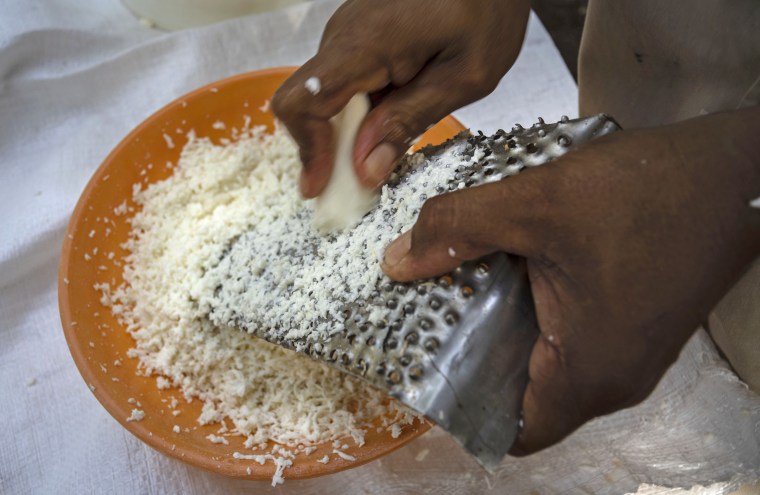QUIVICÁN, Cuba — When Julio César Núñez was a child, he helped his grandmother make casabe from scratch, using artisanal tools — and an ancient cooking method — to turn grated yuca root into a thin, white, crispy flatbread.
Today, Núñez, 80, and a younger generation of family members in this town south of Havana, continue the tradition of harvesting and preparing casabe the ancestral way, but it’s no longer just for their own consumption. They sell it to small businesses and restaurants in the capital.
Casabe, a flatbread made of yuca root, which is also called cassava, is one of Cuba’s oldest Indigenous meals. It is making a comeback on the island nation, with promoters and restaurants hyping its benefits as a gluten-free alternative to bread and officials seeking its addition to the prized intangible cultural heritage list of UNESCO, the U.N.’s cultural agency.
“Casabe is an Amerindian tradition that came from northern South America and made its way to the Antilles,” Sonia Virgen Pérez, president of Cuba’s National Heritage Council, told The Associated Press. “It arrived through the eastern part of Cuba and became an important food that has been passed down from generation to generation.”
In March, Pérez led a delegation of countries including Cuba, Dominican Republic, Venezuela, Honduras and Haiti, to formally request that UNESCO include the tradition of harvesting yuca, and preparing and consuming casabe to its cultural heritage list.
Casabe was a key part of the diet of Indigenous peoples in the Caribbean. It was also among the first native products embraced by the Spaniards upon their arrival. They incorporated it into their diet, partly because of its durability. It can last months once baked.
Less popular than its Latin American cousins — the Mexican tortilla, traditionally made of corn, or the Venezuelan arepa, which tends to be thicker — casabe is increasingly finding its way into culinary festivals and even casabe-themed merchandising. Among its advantages, says Pérez, is that its main ingredient, the yuca root, can be found virtually anywhere in the Cuban countryside.
“Casabe is a synonym for strength and resilience,” she says.

When eaten, casabe resembles a crunchy, somewhat dry cookie that can be accompanied with either sweet foods, such as sugary coconut, or meat and poultry, as long as the addition is moist enough to compensate for casabe’s natural dryness.
“It is one of the oldest dishes in our cuisine,” says Yudisley Cruz, a 45-year-old economist who co-owns Yucasabi, a restaurant in Havana that specializes in dishes based on casabe flatbread. “It goes with everything.”
Back in Quivicán, Núñez walks around the farm, showing a reporter some of the traditional tools he uses to make casabe the way his grandmother did, including a sifter made of natural fibers. A few meters away, his 40-year-old nephew Agustín grates the yuca root while Agustín’s son, Eriel, 15, carefully prepares the small cakes that are then cooked on a griddle over a wood fire.
In addition to seeking UNESCO recognition, casabe enthusiasts hope it will be widely embraced as a healthy, sustainable meal that delights the palate of more people while preserving an Indigenous tradition.
“We’re not going to war against bread. We just want people to also eat casabe,” says Cruz, the restaurateur.






